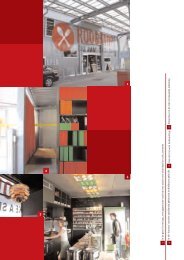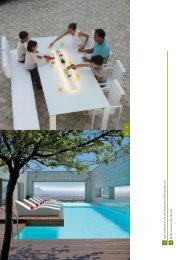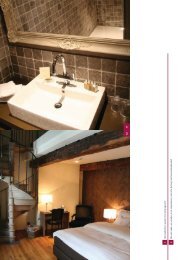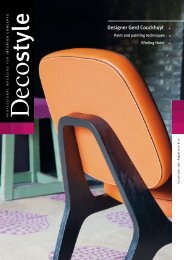Biënnale Interieur 2012 [ 6 ] - Decostyle
Biënnale Interieur 2012 [ 6 ] - Decostyle
Biënnale Interieur 2012 [ 6 ] - Decostyle
Create successful ePaper yourself
Turn your PDF publications into a flip-book with our unique Google optimized e-Paper software.
Round table<br />
Flexible floors<br />
“The individual aspect is becoming ever more important”<br />
The market of flexible floor coverings is on the move. More than in most other areas of interior<br />
decoration, this is a sector in which the technology evolves at lightning speed. But how does<br />
this market deal with other trends, such as the increasing individualization of the interior?<br />
And what about the ecology? We spoke to seven professionals from this sector.<br />
Let us start by giving an overview of the<br />
participants. Tatiana Batache is Sales<br />
& Technical Manager at 4m Europe, a<br />
company specialized in the installation of<br />
epoxy resin and cast floors. Christ Taveirne<br />
is product manager at Moduleo, which imports<br />
modular design floors and tiles and<br />
recently built a plant in Avelgem (Belgium,<br />
West Flanders). Moduleo mainly targets<br />
interior designers and architects for<br />
residential and commercial applications.<br />
mFlor is represented by sales manager<br />
Tom De Rydt. mFlor distributes innovative<br />
design floors, to be used in both<br />
the project and the residential markets.<br />
Next to Tom De Rydt sits Jean-François de<br />
Meester, sales manager at Tarkett Benelux,<br />
which offers vinyl, laminate floors<br />
and parquet floors for the residential market.<br />
Finally, the Balta group is represented<br />
by Geert Vanden Bossche, Philippe Van<br />
Hecke and Christian Ysenbaert. Balta<br />
Broadloom operates in the wider carpet<br />
sector, going from wall-to-wall carpet to<br />
woven rugs and residential tiles.<br />
Flexible floors<br />
First of all, the subject must be clearly<br />
defined. What do our guest speakers<br />
consider to be ‘soft floor coverings’?<br />
“A good question”, reacts Tom De<br />
Rydt. “Not everywhere does this term<br />
refer to the same thing. At mFlor, for<br />
example, we don’t refer to the LVT<br />
floors as soft floor coverings. “With<br />
us it’s different”, says Jean-François<br />
De Meester. “The consumer often<br />
compares vinyl to laminate flooring. In<br />
the DIY shops LVT is to be found in the<br />
decoration department, but we wonder<br />
why this cannot be offered along<br />
with laminate floors?” According to<br />
Tatiane Batache as well there is a very<br />
narrow margin between soft and hard<br />
floor coverings. “You can hardly call<br />
an epoxy carpet soft. It is hard as rock.<br />
Polyurethane on the contrary is a soft<br />
material. The distinction is sometimes<br />
difficult to make.” Philippe Van Hecke<br />
draws a clear line: “Vinyl and textiles<br />
belong in the category of soft floors,<br />
all the rest we refer to as hard.” His<br />
colleague Geert Vanden Bossche differentiates<br />
a little. “Maybe the better<br />
term to use would be ‘flexible floors’.”<br />
Transforming a room<br />
What does our panel consider to<br />
be the advantages of ‘their’ variations<br />
of ‘soft’ floors? Geert Vanden<br />
Bossche: “In the UK, we recently ran<br />
an advertising campaign by Balta<br />
Broadloom under the slogan ‘Carpet<br />
transforms a room’. This is spot-on.<br />
Carpet is a cheap way to create a different<br />
atmosphere inside a room. It<br />
moreover has acoustic advantages, it<br />
is soft and it is comfortable. Despite<br />
the preconceived opinions, carpet is<br />
also easy to maintain.”<br />
“Epoxy resin floors are extremely<br />
handy for renovations in both residential<br />
and commercial environments”,<br />
thinks Christ Taveirne. “This has a lot<br />
to do with the minimal thickness of the<br />
material.” Tatiana Batache agrees with<br />
Christ Taveirne. “The same goes for<br />
polyurethane cast floors. Polyurethane<br />
cast floors weigh very little, as a result<br />
they can also be used in the attic or in<br />
apartments. The aesthetic story also<br />
plays its role: any colour is possible,<br />
we can insert drawings into the floor<br />
and even imitate wood or concrete.”<br />
“The same goes for vinyl”, says Jean-<br />
François de Meester. “These floors are<br />
available in an ever increasing amount<br />
of beautiful colours. The installation<br />
is easy, the maintenance simple, and<br />
unlike laminate floors vinyl provides an<br />
excellent acoustic barrier.”<br />
“Vinyl is a product that is suited for<br />
different kinds of projects”, judges<br />
Tom De Rydt. “The technical side of<br />
the story is right and the floors generally<br />
look very good. But it remains a<br />
fact that every product has its own<br />
characteristics and that an architect<br />
must choose which kind of floor best<br />
meets his requirements. I notice a<br />
certain increasing fluidity in the market<br />
of soft floor coverings. Laminate<br />
flooring, for example, became popular<br />
in a very short period of time.”<br />
Seamless cast floors<br />
Jean-François de Meester already<br />
talked about the installation, a subject<br />
that is of particular importance in a<br />
11 11


![Biënnale Interieur 2012 [ 6 ] - Decostyle](https://img.yumpu.com/7876631/11/500x640/biennale-interieur-2012-6-decostyle.jpg)




![yoo Design Studio [ 6 ] - Decostyle](https://img.yumpu.com/7876175/1/184x260/yoo-design-studio-6-decostyle.jpg?quality=85)